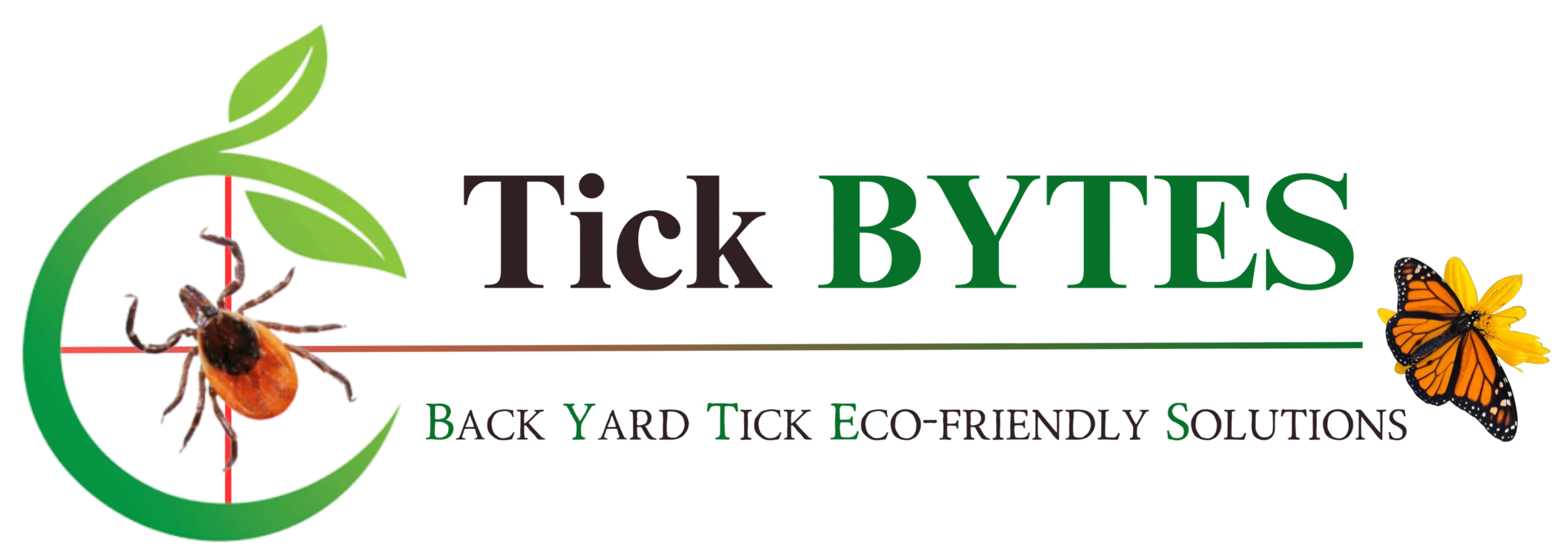Flagging and Dragging for Ticks
My wife Barb and I checked out our granddaughter’s yard after she shared that she was picking up ticks on the mowed back lawn. Like many rural/suburban properties, there is a mix of sun and shade, and the property is surrounded by hardwood and softwood trees, leaf litter, raspberry bushes, etc. There is lots of wildlife in the area, including rodents, deer, and turkeys.
Personal Protection First
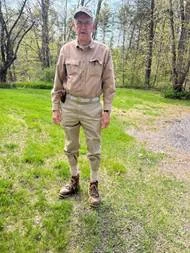


The neighborhood has a history of tick activity, so Barb and I took preventative measures to protect ourselves from unwanted tick encounters. Since I was using the tick drag and entering known tick habitat, I was dressed in light colored, permethrin treated pants and socks from Insect Shield, I made sure that I pulled my socks up over the cuffs of my pants to prevent ticks from crawling up my pant leg. Barb wore Insect Shield socks pulled up over her pant legs and stayed in the mowed area of the lawn.
*Tick Tip* Download our FREE guide “Protection Strategies: Home & Away” for more tips to protect your family from tick encounters.
One of the tenets of Integrated Pest Management (IPM) is to understand the life cycle and positively identify the pests to be controlled. It may be difficult for the average homeowner to understand the abundance of ticks on their property and positively identify the various species – the larval and nymph stages are tiny so that we may only see them when they’re attached to ourselves, a child or a pet. For assistance with tick identification, use the TickEncounter Field Guide.
Flagging and Dragging for Ticks
How do we get a true measure of what might be on the property? Use a tick drag. It’s as simple as dragging a cloth behind a person walking the property. For years, researchers have been employing tick drags to collect and analyze ticks; now you can also employ this technique.
We built two simple tools:
Dragging – the flannel is attached to a dowel and rope to drag directly on the lawn area.
Flagging – a second unit with an offset pole and cloth to check those areas with vegetation that are not easily accessible to walking.
For this session, we checked 200’ linear feet of perimeter (flagging) and approximately 3,000 square feet of lawn area (dragging).
Typically, 80% of deer ticks are picked up within 10’ of the perimeter – that area of your property defined by the interface of the lawn and wooded edge. Deer ticks require a damp, humid environment to survive. Dog ticks are more frequently found in tall grass (fields) and closer to residential dwellings – since they are less susceptible to drying out like the deer tick and the dog ticks can tolerate more temperate locations.
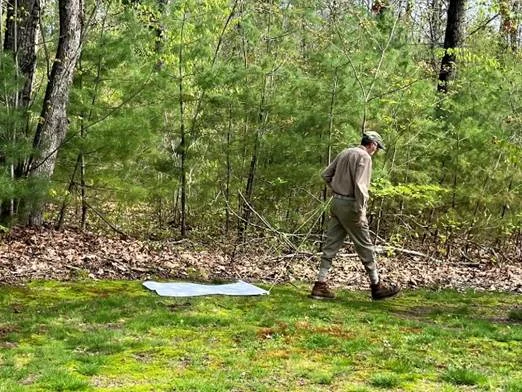
Dragging – We started our tick drag by dragging the lawn area directly adjacent to the perimeter utilizing the ordinary “flat” tick drag material that I dragged behind while walking. We ended up picking up two deer ticks and two dog ticks following a series of sweeps covering a total of 25’ wide and 40’ in length (approximately 2’ wide area per sweep).
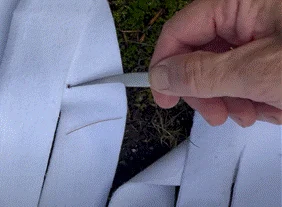
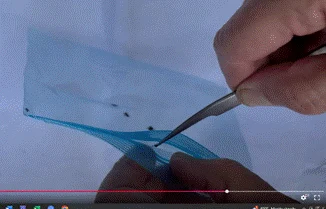
When we found ticks attached to the cloth, we used a pair of fine pointed tweezers to remove the ticks and placed them securely in a zip-lock bag.

Flagging – We used our offset cloth flagger and handle and began sweeping the perimeter within 2’ of the lawn edge. We periodically stopped and checked for ticks. Our first stop after about 50’ of flagging yielded three ticks – all deer ticks. We continued to sweep an additional 30’ of perimeter and found four more deer ticks and one dog tick. Note: For this exercise, the perimeter was simply that area about 2 feet (the width of our drag) into the leaf litter and vegetation at the wooded edge. We did not travel any further into the perimeter of the property.
Our Results
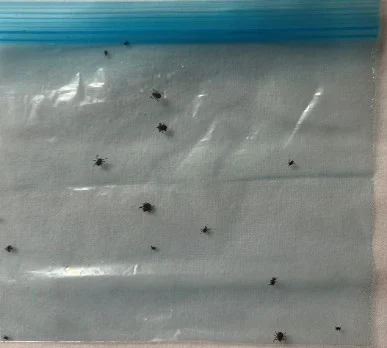
We ended up spending about 35 minutes dragging and flagging the remainder of the back and side yards and found a total of 17 ticks – 5 dog ticks (1 female, 4 male) and 12 deer ticks (6 female, 6 male).
4 ticks were collected on the lawn area, and 13 ticks from the immediate perimeter of the property.
Flagging and dragging devices are routinely used by professionals to collect ticks for various research opportunities. If you’re looking to accurately determine the level of tick activity on your property as well as measuring long-term efficacy of any treatment protocol that you employ, this is by far the most time-tested and accurate method to utilize. Remember to dress appropriately.
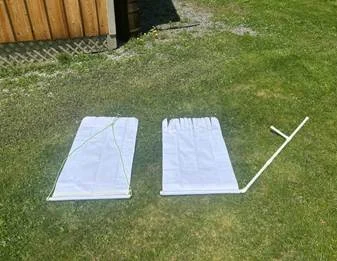
Citizen Scientists
Would you like to construct the tick drag and flag pictured? The flat drag is easy to construct using either a wooden dowel or 30” length of PVC, an 8’ length of rope, a length of white material, and duct tape to secure the material to the dowel. For the material, we favor a flannel waterproof crib sheet fabric measuring 27” x 52” for both the flat drag and the flagging drag as the material is snag-proof and highly durable when used in dense and thorny vegetation. You could also use ordinary light-colored flannel material, a white towel or even a pillowcase.
The flagging sweep drag with the pvc handle allows the user to stand and walk along with the flag parallel to the ground, which allows effective movement beside dense leaf litter, beneath low and fallen branches, and in and around shrubs where ticks may be questing without walking through that tangled area. The rubberized-laminated waterproof fabric is the best option for this drag. The handle is made of pvc pipe and fittings.
DIY Email us at www.info@tickbytes.us and we’ll send you step-by-step directions to construct your own flagging and dragging tools with construction details and materials list. This is an easy and affordable DIY project that will allow you to identify where ticks are in your backyard so that you can develop a treatment protocol and designate tick-safer areas on your property.
Once you’ve collected your ticks, you can submit them to your state or province agency that is responsible for gathering tick information. In Maine, that agency would be the UMaine Tick Lab. Contact your state or province Cooperative Extension Service for tick submission labs in your area.
Bob Maurais, Tick BYTES Integrated Pest Management Coordinator, has been certified as a Commercial Master Pest Applicator in Maine for over 20 years, a member of the IPM Working Group, and has developed content and presentations at local, state, and national conferences. Barb Maurais, president of Tick BYTES, is a Lyme and associated diseases advocate, and has presented educational trainings and workshops to numerous community groups and organizations throughout Southern Maine. Tick BYTES is a web based eco-friendly resource that provides you with DIY pest solutions for you, your neighbors, and your community.
